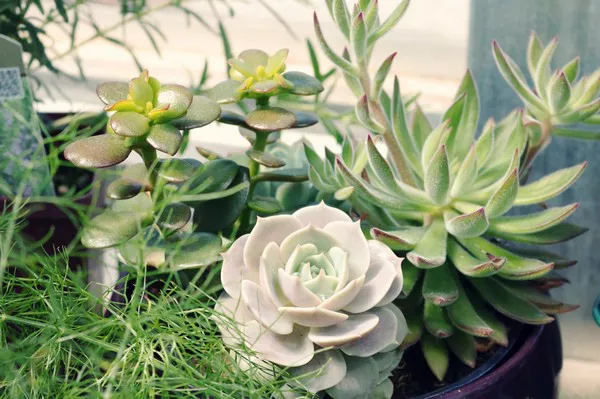Succulents, with their diverse shapes, colors, and low-maintenance nature, make them an ideal choice for creating stunning and harmonious arrangements. Planting succulents together not only allows for creative expression but also provides an opportunity to explore various combinations of textures and forms. In this comprehensive guide, we will delve into the art of planting succulents together, offering insights into selection, arrangement, and care to ensure a thriving and visually appealing succulent ensemble.
Choosing Complementary Succulents
The foundation of a successful succulent arrangement lies in thoughtful selection. Choose succulents that complement each other in terms of color, size, and growth habits. Consider the visual impact of combining different shapes, such as rosettes, trailing varieties, and upright growers. Varied textures, such as smooth, spiky, or fuzzy, add depth to the arrangement. Assess the lighting conditions in the chosen location, opting for succulents with similar sunlight requirements to ensure that each plant in the ensemble receives the optimal light it needs.
Understanding Growth Patterns
Succulents exhibit diverse growth patterns, ranging from compact rosettes to sprawling ground covers. When planting succulents together, understanding their growth habits is essential. Arrange succulents with similar growth patterns side by side to create a cohesive and balanced look. Consider the ultimate size of each succulent, allowing ample space for growth without overcrowding. Strategic placement based on growth patterns ensures that each succulent has room to thrive and contributes to the overall visual harmony of the arrangement.
Selecting a Suitable Container
Choosing the right container is a crucial step in planting succulents together. Opt for containers with adequate drainage holes to prevent waterlogged soil, which can lead to root rot. Additionally, consider the aesthetic appeal of the container, selecting one that complements the colors and forms of the succulents. Containers made from materials like terra cotta, concrete, or ceramic provide stability and breathability for succulent roots. The size of the container should accommodate the selected succulents while leaving space for growth.
See Also: How to quickly propagate succulents?
Creating a Well-Draining Soil Mix
Succulents thrive in well-draining soil that prevents excess moisture around their roots. Prepare a specialized succulent or cactus soil mix or create your own by combining regular potting soil with perlite or coarse sand. This blend ensures proper drainage while providing the essential nutrients succulents need to thrive. When planting succulents together, fill the container with the well-draining soil mix, leaving enough space for the root systems of each succulent.
Arranging Succulents with Aesthetic Harmony
The arrangement of succulents is an art form that involves considering color, height, and form to create visual harmony. Arrange succulents with complementary colors, placing contrasting shades next to each other for a striking effect. Play with height variations, positioning taller succulents towards the center and gradually introducing shorter varieties towards the edges. Consider the overall shape of the arrangement, aiming for a balanced and aesthetically pleasing composition.
Planting Techniques for Different Varieties
Succulents come in various varieties, each with its unique characteristics. Understanding the planting techniques for different succulent types is essential for their successful integration into an arrangement. For example, when planting rosette succulents, ensure that their central crowns are slightly elevated above the soil level to prevent water accumulation. For trailing succulents, position them near the edges of the container, allowing their stems to cascade gracefully.
Mindful Watering Practices
Watering succulents together requires a mindful approach to prevent overwatering and ensure optimal health. Succulents prefer a “soak and dry” watering method, where the soil is thoroughly moistened, and then allowed to dry out completely before the next watering. Be attentive to individual water requirements, as different succulent varieties may have varying preferences. Avoid watering the foliage directly to prevent rot, and always water the soil at the base of the plants.
Providing Adequate Sunlight
Succulents are known for their love of sunlight, and providing adequate light is crucial for their overall well-being. When planting succulents together, choose a location that receives ample sunlight, preferably a few hours of indirect sunlight daily. If growing indoors, position the arrangement near a south-facing window to ensure sufficient light exposure. Rotate the container periodically to promote even growth and prevent stretching towards the light source.
Regular Maintenance and Pruning
Maintaining the beauty of a succulent ensemble involves regular care and occasional pruning. Remove any dead or decaying leaves to encourage air circulation and prevent the spread of disease. Prune succulents that become leggy or overgrown, promoting a compact and tidy appearance. Monitoring the arrangement for signs of pests or diseases allows for timely intervention and ensures the continued health of the succulents.
Overwintering Succulents Together
In regions with colder climates, overwintering succulents together requires special attention. Consider bringing outdoor succulent arrangements indoors before the first frost to protect them from freezing temperatures. Place them in a well-lit area with good air circulation, and reduce watering during the dormant winter months. Monitor the succulents for signs of stress, such as stretching or discoloration, and adjust their care accordingly.
Experimenting with Color Themes
For a more cohesive and visually impactful succulent arrangement, consider experimenting with color themes. Create a monochromatic ensemble using succulents with varying shades of the same color, or opt for a harmonious blend of complementary hues. Varied color themes add depth and interest to the arrangement while allowing for creative expression. Whether opting for a serene green palette or a vibrant mix of colors, experimenting with themes enhances the overall aesthetic appeal of the succulent ensemble.
Conclusion
Planting succulents together is a delightful endeavor that invites creativity and showcases the beauty of these unique plants. By carefully selecting complementary succulents, understanding their growth patterns, and arranging them with aesthetic harmony, you can create a visually stunning ensemble. Providing proper care, including well-draining soil, mindful watering, and strategic pruning, ensures the continued health and vitality of the succulent arrangement. Whether displayed indoors or outdoors, a well-crafted succulent ensemble adds a touch of natural elegance to any space, bringing joy to plant enthusiasts and admirers alike.


